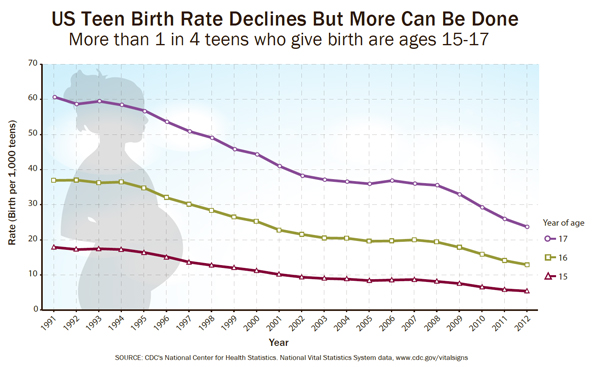Younger teens still account for 1 in 4 teen births
Despite recent progress, more can be done to prevent pregnancies in younger teens
Press Release
Embargoed until: Tuesday, April 8, 2014, 1:00pm ET
Contact: Media Relations
(404) 639-3286
 [PDF]
[PDF]US Teen Birth Rate Declines But More Can be Done Entire infographic
Although births to younger teens aged 15 to 17 years have declined, they still represent over a quarter of teen births – nearly 1,700 births a week, according to this month’s Vital Signs. This reinforces the need for targeted interventions to prevent teen pregnancy, says the report by the Centers for Disease Control and Prevention.
“Although we have made significant progress reducing teen pregnancy, far too many teens are still having babies,” said CDC Director Tom Frieden, M.D., M.P.H. “Births to younger teens pose the greatest risk of poor medical, social and economic outcomes. Efforts to prevent teen childbearing need to focus on evidence-based approaches to delaying sexual activity and increasing use of the most effective methods of contraception for those teens who are sexually active.”
CDC researchers analyzed birth data from the National Vital Statistics System and adolescent health behavior data from the National Survey of Family Growth.
Findings include:
- The rate of births per 1,000 teens aged 15 to 17 years declined 63 percent, from 38.6 in 1991 to 14.1 in 2012.
- The birth rate to younger teens is higher for Hispanic, non-Hispanic black and American Indian/Alaska Native teens. In 2012, the birth rate per 1,000 teens aged 15 to 17 years was 25.5 for Hispanic teens, 21.9 for non-Hispanic black teens, 17 for American Indian/Alaska Native teens, 8.4 for non-Hispanic white teens and 4.1 for Asian/Pacific Islander teens.
- Most teens aged 15-17 (73 percent) had not had sex yet.
- Nearly 1 in 4 teens in this age group never spoke with their parents or guardians about sex.
Other findings about sexually active teens in this age group include:
- More than 80 percent had not received any formal sex education before they had sex for the first time.
- More than 90 percent of teens used some form of contraception the last time they had sex, but most of them relied on methods that are among the least effective.
The Vital Signs report also underscores findings from previous CDC reports on teen pregnancy prevention:
- Racial and ethnic disparities in teen pregnancy rates remain, suggesting the continued need for culturally appropriate interventions and services.
- Sexually active teens remain at risk for pregnancy because they use less-effective contraceptives.
- Earlier delivery of prevention efforts may further increase abstinence and birth control use.
- Parents and guardians can play an influential role in helping pre-teens and teens avoid risky sexual behaviors.
“We need to provide young people with the support and opportunities they need to empower themselves. Trying to balance the task of childbearing while trying to complete their high school education is a difficult set of circumstances, even with the help of family and others,” said Shanna Cox, M.S.P.H., CDC’s Division of Reproductive Health. “Teens who give birth are at increased risk of having a repeat birth while still a teenager. And these younger teens are less likely to earn a high school diploma or GED than older teens who give birth.”
May is Teen Pregnancy Prevention Month. This Vital Signs report was created to help the nation’s communities continue the dialogue about teen pregnancy and its burden on our nation’s youth. For more information about teen pregnancy visit http://www.cdc.gov/TeenPregnancy/.
Vital Signs is a CDC report that appears on the first Tuesday of the month as part of the CDC journal Morbidity and Mortality Weekly Report, or MMWR. The report provides the latest data and information on key health indicators. These are cancer prevention, obesity, tobacco use, motor vehicle passenger safety, prescription drug overdose, HIV/AIDS, alcohol use, health care-associated infections, cardiovascular health, teen pregnancy, food safety and developmental disabilities.
